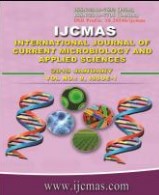


 National Academy of Agricultural Sciences (NAAS)
National Academy of Agricultural Sciences (NAAS)

|
PRINT ISSN : 2319-7692
Online ISSN : 2319-7706 Issues : 12 per year Publisher : Excellent Publishers Email : editorijcmas@gmail.com / submit@ijcmas.com Editor-in-chief: Dr.M.Prakash Index Copernicus ICV 2018: 95.39 NAAS RATING 2020: 5.38 |
Corynespora leaf fall (CLF) disease of rubber incited by Corynespora cassiicola is listed as a fourth most serious leaf disease of rubber in South East Asia. As the rubber is a tree crop it grows up to 60 – 70 feet height, management of this disease is not easy and it involves more price tag. The use of effective and economical management strategies is plays a vital role in efficient disease management in rubber plantations. To develop a tool to integrated disease management approach, tested different bio-agents, plant extracts and fungicides against Corynespora cassiicola. Among the bio-agents tested Trichoderma viride inhibited the growth of fungus to the maximum extent followed by T. harzianum, Bacillus subtilis and to some extent Pseudomonas florescence. Complete inhibition of the fungal growth was not observed in any of the botanicals used. However, considerable amount of growth inhibition was noticed in garlic bulb extract and neem seed kernel extract. Among the fungicides tested SAAF [combination fungicide containing mancozeb and carbendazim] @ 2g/l was found to be more effective as compared to other fungicides. SAAF a fungicide having both contact and systemic action it provides additional protection to the plants form bud break to various stages of leaf development. The information generated from the study could be a useful in develop the tool to an integrated CLF disease management in rubbers plantation.
 |
 |
 |
 |
 |